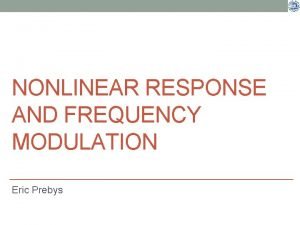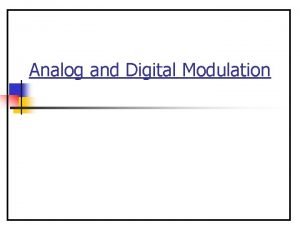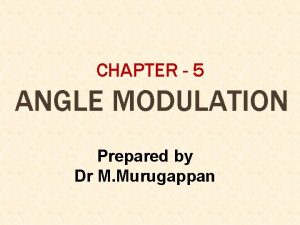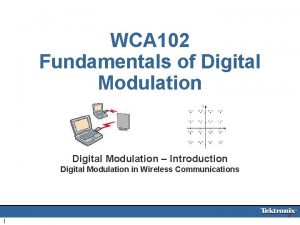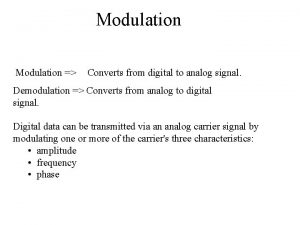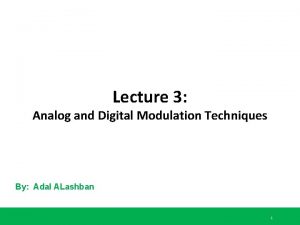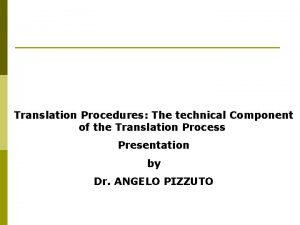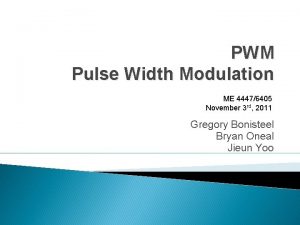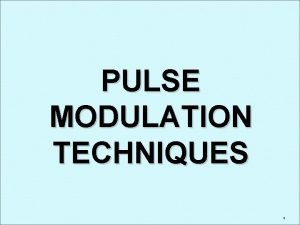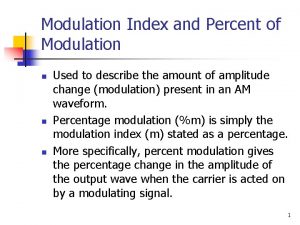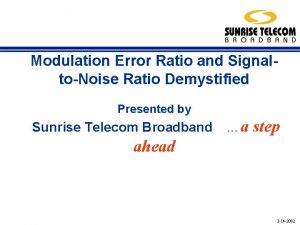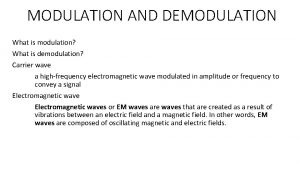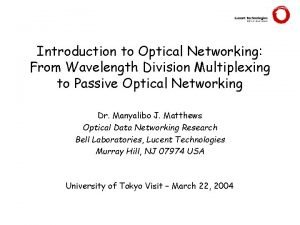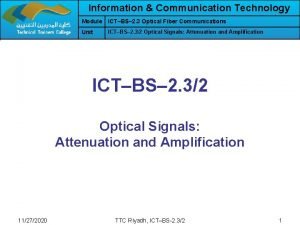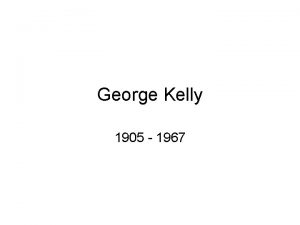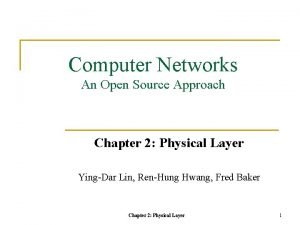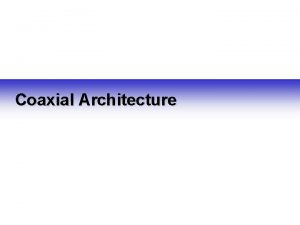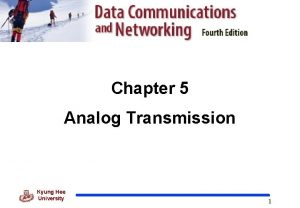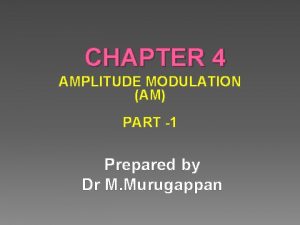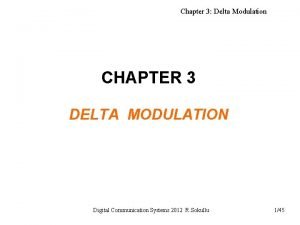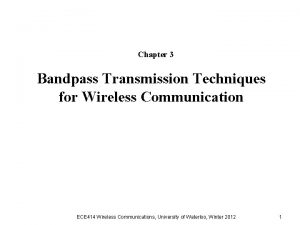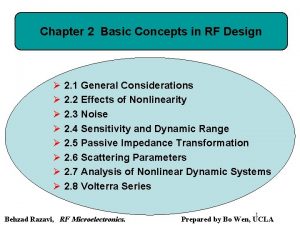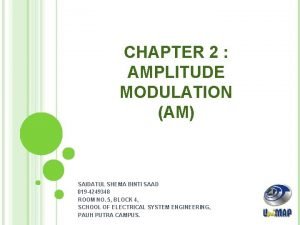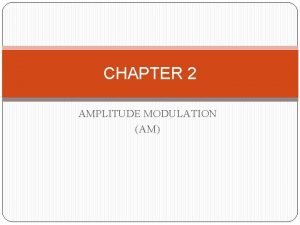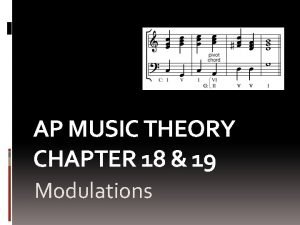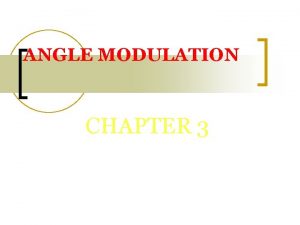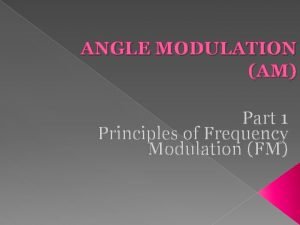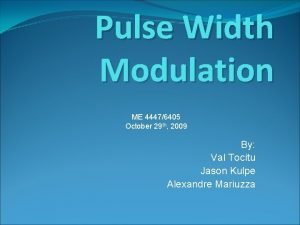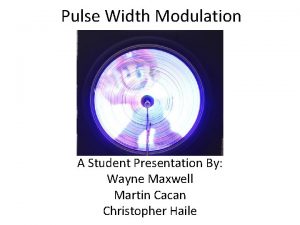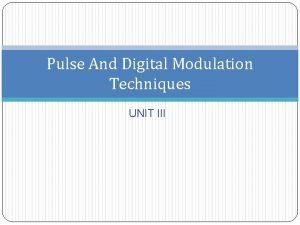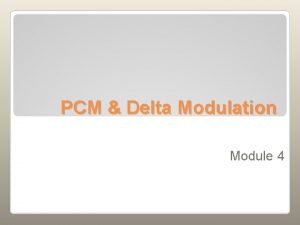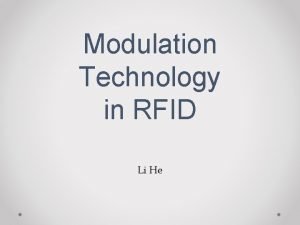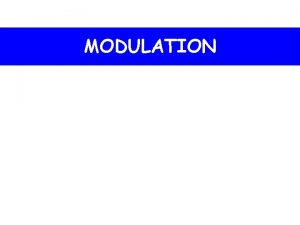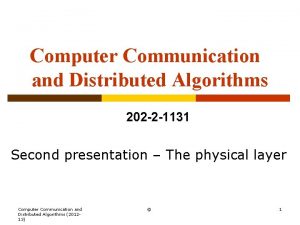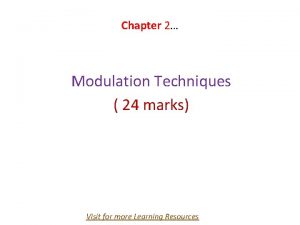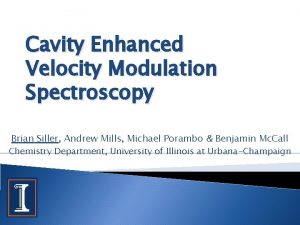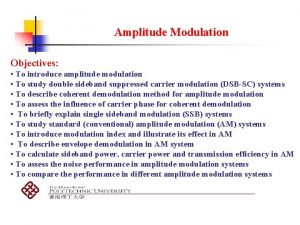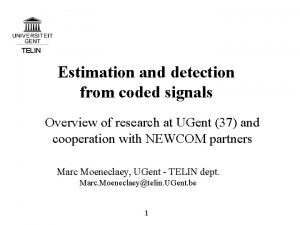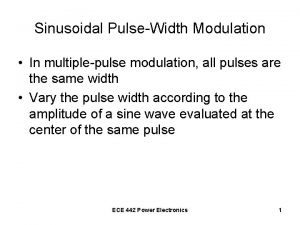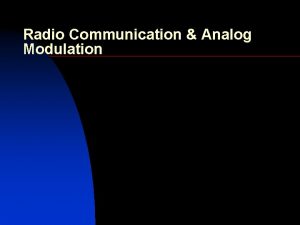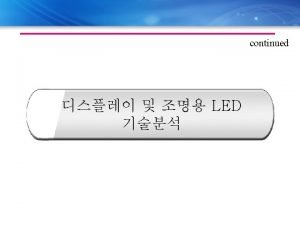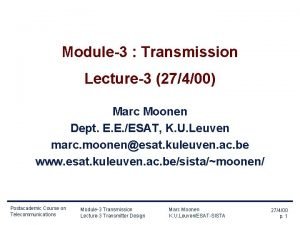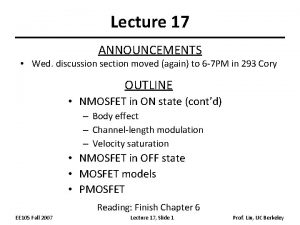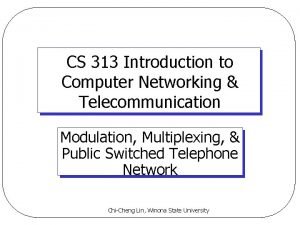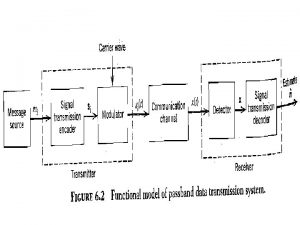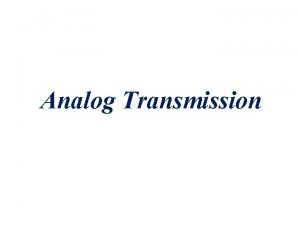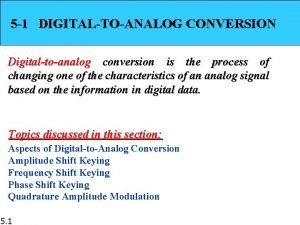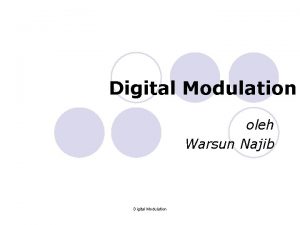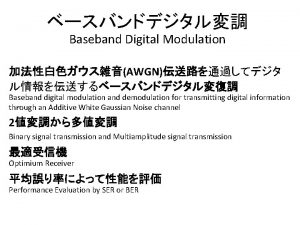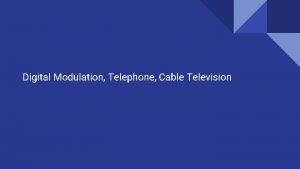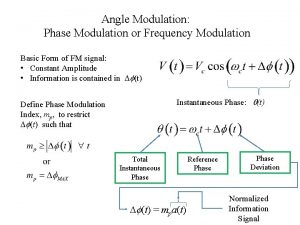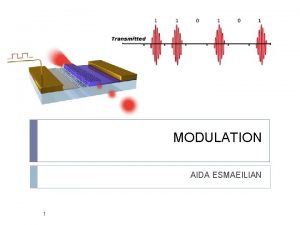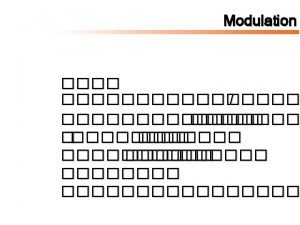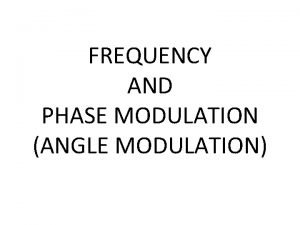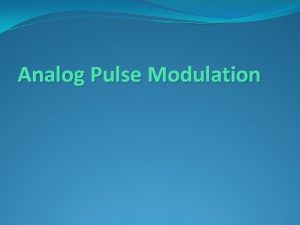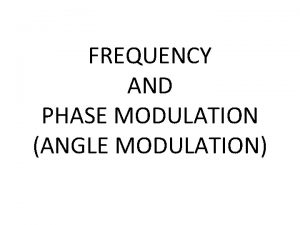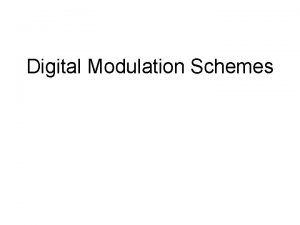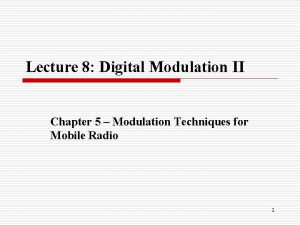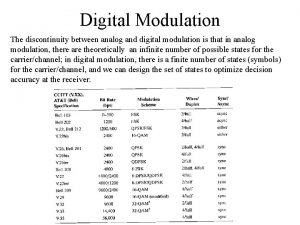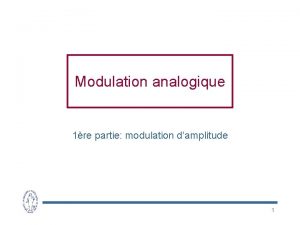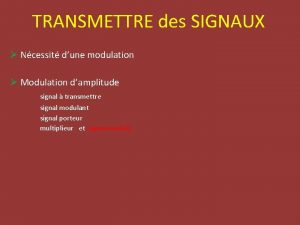DIGITAL MODULATION Digitaltoanalog modulation Digitaltoanalog modulation Why Digitaltoanalog








































































- Slides: 72

DIGITAL MODULATION

Digital-to-analog modulation (Digital-to-analog modulation)

Why Digital-to-analog modulation ?

Why Digital-to-analog modulation ? q Digital signals can be transmitted directly at baseband only under limited conditions. q For wireless RF transmission some form of modulation is required to shift the spectra. q Here key concerns are bandwidth efficiency and implementation complexity. These are affected by: base band pulse shape phase transition characteristics envelope fluctuations

Signal corruption The bandwidth is a property of a medium: It is the difference between the highest and the lowest frequencies that the medium can satisfactorily pass.

Example A signal has a spectrum with frequencies between 1000 and 2000 Hz (bandwidth of 1000 Hz). A medium can pass frequencies from 3000 to 4000 Hz (a bandwidth of 1000 Hz). Can this signal faithfully pass through this medium?

Example A signal has a spectrum with frequencies between 1000 and 2000 Hz (bandwidth of 1000 Hz). A medium can pass frequencies from 3000 to 4000 Hz (a bandwidth of 1000 Hz). Can this signal faithfully pass through this medium? Solution The answer is definitely no. Although the signal can have the same bandwidth (1000 Hz), the range does not overlap. The medium can only pass the frequencies between 3000 and 4000 Hz; the signal is totally lost.

Low-pass and band-pass

Digital transmission needs a low-pass channel. Analog transmission can use a bandpass channel.

What are the different Types of Digital-toanalog modulation ?

What are the different Types of Digital-toanalog modulation ? q ASK involves turning a carrier on and off to represent the binary values. q FSK involves switching between two frequencies that represent the binary values. q PSK involves switching between two phases that represent the binary values q QAM is a combination of both ASK and PSK

Types of digital-to-analog modulation

What is the difference between Baud rate and Bit rate

What is the difference between Baud rate and Bit rate is the number of bits per second. Baud rate is the number of signal units per second. Baud rate is less than or equal to the bit rate.

Bit and baud Bit and Baud

Example An analog signal carries 4 bits in each signal unit. If 1000 signal units are sent per second, find the baud rate and the bit rate Solution Baud rate = 1000 bauds per second (baud/s) Bit rate = 1000 x 4 = 4000 bps

Example The bit rate of a signal is 3000. If each signal unit carries 6 bits, what is the baud rate? Solution Baud rate = 3000 / 6 = 500 baud/s

ASK Describe Amplitude Shift Keying

ASK Describe Amplitude Shift Keying Amplitude-shift keying (ASK) is a form of modulation that represents digital data as variations in the amplitude of a carrier wave.

The simplest and most common form of ASK operates as a switch, using the presence of a carrier wave to indicate a binary one and its absence to indicate a binary zero. This type of modulation is called on-off keying,

What is Relationship between baud rate and bandwidth in ASK

What is Relationship between baud rate and bandwidth in ASK

Example Find the minimum bandwidth for an ASK signal transmitting at 2000 bps. The transmission mode is halfduplex.

Example Find the minimum bandwidth for an ASK signal transmitting at 2000 bps. The transmission mode is halfduplex. Solution In ASK the baud rate and bit rate are the same. The baud rate is therefore 2000. An ASK signal requires a minimum bandwidth equal to its baud rate. Therefore, the minimum bandwidth is 2000 Hz.

Example Given a bandwidth of 5000 Hz for an ASK signal, what are the baud rate and bit rate?

Example Given a bandwidth of 5000 Hz for an ASK signal, what are the baud rate and bit rate? Solution In ASK the baud rate is the same as the bandwidth, which means the baud rate is 5000. But because the baud rate and the bit rate are also the same for ASK, the bit rate is 5000 bps.

Example Given a bandwidth of 10, 000 Hz (1000 to 11, 000 Hz), draw the full-duplex ASK diagram of the system. Find the carriers and the bandwidths in each direction. Assume there is no gap between the bands in the two directions.

Example Given a bandwidth of 10, 000 Hz (1000 to 11, 000 Hz), draw the full-duplex ASK diagram of the system. Find the carriers and the bandwidths in each direction. Assume there is no gap between the bands in the two directions. Solution For full-duplex ASK, the bandwidth for each direction is BW = 10000 / 2 = 5000 Hz The carrier frequencies can be chosen at the middle of each band fc (forward) = 1000 + 5000/2 = 3500 Hz fc (backward) = 11000 – 5000/2 = 8500 Hz

Solution to Example

ASK 1. 2. 3. 4. Susceptible to sudden gain changes Inefficient modulation technique On voice-grade lines, used up to 1200 bps Used to transmit digital data over optical fiber

FSK Describe Frequency Shift Keying Frequency-shift keying (FSK) is a frequency modulation scheme in which digital information is transmitted through discrete frequency changes of a carrier wave. The simplest FSK is binary FSK (BFSK).

Frequency Shift Keying (FSK) Two binary digits represented by two different frequencies near the carrier frequency where f 1 and f 2 are offset from carrier frequency fc by equal but opposite amounts

FSK Generation FSK features 1. 2. 3. 4. Less susceptible to error than ASK On voice-grade lines, used up to 1200 bps Used for high-frequency (3 to 30 MHz) radio transmission Can be used at higher frequencies on LANs that use coaxial cable

Relationship between baud rate and bandwidth in FSK what is the Relationship between baud rate and bandwidth in FSK ?

Example Find the minimum bandwidth for an FSK signal transmitting at 2000 bps. Transmission is in half-duplex mode, and the carriers are separated by 3000 Hz. Solution For FSK BW = baud rate + fc 1 - fc 0 BW = bit rate + fc 1 - fc 0 = 2000 + 3000 = 5000 Hz

Example Find the maximum bit rates for an FSK signal if the bandwidth of the medium is 12, 000 Hz and the difference between the two carriers is 2000 Hz. Transmission is in full-duplex mode. Solution Because the transmission is full duplex, only 6000 Hz is allocated for each direction. BW = baud rate + fc 1 - fc 0 Baud rate = BW - (fc 1 - fc 0 ) = 6000 - 2000 = 4000 But because the baud rate is the same as the bit rate, the bit rate is 4000 bps.

Relationship between baud rate and bandwidth in FSK what is the Relationship between baud rate and bandwidth in FSK ?

Relationship between baud rate and bandwidth in FSK Minimum frequency-shift keying or minimum-shift keying (MSK) is a particularly spectrally efficient form of coherent FSK. In MSK the difference between the higher and lower frequency is identical to half the bit rate. As a result, the waveforms used to represent a 0 and a 1 bit differ by exactly half a carrier period. This is the smallest FSK modulation index that can be chosen such that the waveforms for 0 and 1 are orthogonal. A variant of MSK called GMSK is used in the GSM mobile phone standard.

Relationship between baud rate and bandwidth in FSK Minimum frequency-shift keying

Relationship between baud rate and bandwidth in FSK Gaussian Minimum frequency-shift keying q. Gaussian minimum shift keying or GMSK is a continuousphase frequency-shift keying modulation scheme. q. It is similar to standard minimum-shift keying (MSK); however the digital data stream is first shaped with a Gaussian filter before being applied to a frequency modulator. q. This has the advantage of reducing sideband power, which in turn reduces out-of-band interference between signal carriers in adjacent frequency channels.

Relationship between baud rate and bandwidth in FSK Gaussian Minimum frequency-shift keying

• With Gaussian minimum shift keying, the rectangular pulses representing input bits are converted into Gaussian shaped pulses. The resulting carrier signal is smooth in phase, and therefore requires less bandwidth to transmit. The configuration shown here uses a bandwidth–bit-time product of 1/5.

PSK Describe Phase Shift Keying Phase-shift keying (PSK) is a digital modulation scheme that conveys data by changing, or modulating, the phase of a reference signal (the carrier wave).

Binary Phase Shift Keying (BPSK) Uses two phases to represent binary digits

Draw BPSK constellation

Draw BPSK constellation

The 4 -PSK method Quadrature phase-shift keying (QPSK or 4 -PSK)

The 4 -PSK characteristics QPSK constellation

The 4 -PSK characteristics QPSK = 4 -PSK

The 4 -PSK characteristics p/4 QPSK

The 4 -PSK characteristics p/4 QPSK

The 8 -PSK characteristics 8 - PSK constellation

What is the Relationship between baud rate and bandwidth in PSK

Example Find the bandwidth for a 4 -PSK signal transmitting at 2000 bps. Transmission is in half-duplex mode. Solution For PSK the baud rate is the same as the bandwidth, which means the baud rate is 5000. But in 8 -PSK the bit rate is 3 times the baud rate, so the bit rate is 15, 000 bps.

What is the QAM ? Quadrature amplitude modulation is a combination of ASK and PSK so that a maximum contrast between each signal unit (bit, dibit, tribit, and so on) is achieved.

The 4 -QAM and 8 -QAM constellations 4 – QAM and 8 -QAM constellations

Time domain for an 8 -QAM signal 8 – QAM in Time Domain

16 -QAM constellations 16 – QAM constellations

Bit and baud rate comparison Modulation Units Bits/Baud rate Bit Rate Bit 1 N N 4 -PSK, 4 -QAM Dibit 2 N 2 N 8 -PSK, 8 -QAM Tribit 3 N 3 N 16 -QAM Quadbit 4 N 4 N 32 -QAM Pentabit 5 N 5 N 64 -QAM Hexabit 6 N 6 N 128 -QAM Septabit 7 N 7 N 256 -QAM Octabit 8 N 8 N ASK, FSK, 2 -PSK

Example A constellation diagram consists of eight equally spaced points on a circle. If the bit rate is 4800 bps, what is the baud rate? Solution

Example A constellation diagram consists of eight equally spaced points on a circle. If the bit rate is 4800 bps, what is the baud rate? Solution The constellation indicates 8 -PSK with the points 45 degrees apart. Since 23 = 8, 3 bits are transmitted with each signal unit. Therefore, the baud rate is 4800 / 3 = 1600 baud

Example Compute the bit rate for a 1000 -baud 16 -QAM signal. Solution

Example Compute the bit rate for a 1000 -baud 16 -QAM signal. Solution A 16 -QAM signal has 4 bits per signal unit since log 216 = 4. Thus, (1000)(4) = 4000 bps

Example Compute the baud rate for a 72, 000 -bps 64 -QAM signal. Solution

Example Compute the baud rate for a 72, 000 -bps 64 -QAM signal. Solution A 64 -QAM signal has 6 bits per signal unit since log 2 64 = 6. Thus, 72000 / 6 = 12, 000 baud

Example Modulation Schemes for Wireless Telephone Modems

Example Modulation Schemes for Wireless Telephone Modems

Example Modulation Schemes for Wireless Telephone Modems

Example Modulation Schemes for Wireless Telephone Modems

Example Modulation Schemes for Wireless Telephone Modems

Considerations in Choice of Telephone. Modulation Modems. Scheme Coherent detection » Receiver users the carrier phase to detect signal » Cross correlate with replica signals at receiver » Match within threshold to make decision Noncoherent detection » Does not exploit phase reference information » Less complex receiver, but worse performance

Considerations in Choice of Telephone. Modulation Modems. Scheme o o o o o High spectral efficiency High power efficiency Robust to multipath effects Low cost and ease of implementation Low carrier-to-cochannel interference ratio Low out-of-band radiation Constant or near constant envelope Constant: only phase is modulated Non-constant: phase and amplitude modulated
 Hey hey bye bye
Hey hey bye bye Amplitude modulation vs frequency modulation
Amplitude modulation vs frequency modulation Amplitude modulation vs frequency modulation
Amplitude modulation vs frequency modulation Advantages of angle modulation
Advantages of angle modulation Advantages of digital modulation
Advantages of digital modulation Modulation digital to analog
Modulation digital to analog Disadvantages of fsk
Disadvantages of fsk Pcm receiver
Pcm receiver Dont ask why why why
Dont ask why why why Apa pengertian dari warga digital
Apa pengertian dari warga digital Digital market and digital goods
Digital market and digital goods Digital data digital signals
Digital data digital signals Digital data transmission
Digital data transmission E-commerce: digital markets, digital goods
E-commerce: digital markets, digital goods Data encoding techniques in computer networks
Data encoding techniques in computer networks Rdi board
Rdi board E-commerce digital markets digital goods
E-commerce digital markets digital goods Tv middleware
Tv middleware Why-why analysis
Why-why analysis Why do you cry willie why do you cry
Why do you cry willie why do you cry Does the table represent a function why or why not
Does the table represent a function why or why not What does the image represent
What does the image represent Why or why not
Why or why not Contoh laporan root cause analysis
Contoh laporan root cause analysis Translation modulation
Translation modulation Tina champagne sensory modulation
Tina champagne sensory modulation Trail edge modulation
Trail edge modulation Pulse code modulation conclusion
Pulse code modulation conclusion Percentage of modulation
Percentage of modulation Meruuu
Meruuu What is demodulation? *
What is demodulation? * Kinematik sport
Kinematik sport Onu
Onu Direct modulation
Direct modulation Modulation coding scheme
Modulation coding scheme Constructive alternativism kelly
Constructive alternativism kelly Ask modulation constellation diagram
Ask modulation constellation diagram Cross modulation
Cross modulation Ask modulation constellation diagram
Ask modulation constellation diagram Dscfc
Dscfc White noise in analog communication
White noise in analog communication Demodulation of delta modulation
Demodulation of delta modulation Probability of error
Probability of error Cross modulation
Cross modulation Modulation envelope
Modulation envelope Principle of am
Principle of am Sequential modulation
Sequential modulation Formula for modulation index
Formula for modulation index Formula for modulation index
Formula for modulation index Single tone modulation
Single tone modulation Severn suzuki speech modulation
Severn suzuki speech modulation Advantages of pwm
Advantages of pwm What is duty cycle
What is duty cycle Pulse code modulation and demodulation
Pulse code modulation and demodulation Manchester encoding scheme
Manchester encoding scheme Calculate quantization error
Calculate quantization error Rfid modulation techniques
Rfid modulation techniques Significance of modulation index
Significance of modulation index Ads b modulation
Ads b modulation Frequency shift keying modulation
Frequency shift keying modulation Disadvantages of pam
Disadvantages of pam Brian siller
Brian siller Source modulation in aas
Source modulation in aas Envelop
Envelop Rao
Rao Multiple pulse width modulation
Multiple pulse width modulation Modulation multiplexing
Modulation multiplexing Anime hemtal
Anime hemtal Linear modulation
Linear modulation Channel length modulation
Channel length modulation Channel length modulation
Channel length modulation Modulation in computer network
Modulation in computer network Flame atomization process
Flame atomization process

